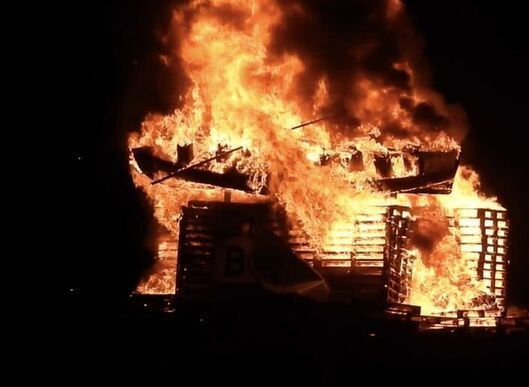Kathleen Donohoe.
PHOTO BY BEOWULF SHEEHAN
Page Turner / Edited by Peter McDermott
When “We Are Not Ourselves” – a multi-generational novel about an Irish-American family in Woodside, Queens – was published in 2014, Vanity Fair’s description of it as a “masterly debut” summarized the reception for one of the critical success stories of that year.
Now its author, Matthew Thomas, is among those heaping the praise on another debut novel about a multi-generational New York Irish family. Kathleen Donohoe’s “Ashes of Fiery Weather,” though, is set in Brooklyn.
Said Thomas of a book that will be published next week: “Donohoe must have had to assimilate the entire postwar history of the Irish on both sides of the Atlantic to produce such a remarkably authentic portrait, rich in memorable detail, with characters that come so vividly to life one forgets one is reading a novel. The anthropological work here is extraordinary. For a book to cover wide swathes of time and still feel vital at every point on its timeline is an impressive feat.”
Donohoe herself said the novel is “about six generations of women from a Brooklyn, New York, family of firefighters, from the Great Hunger to 10 years after Sept. 11.”
She added: “My father, four uncles and my cousin are New York City firefighters. I grew up in Midwood and my dad’s firehouse for most of my childhood was Ladder 156 on 14th Street, near Kings Highway.”
The audiences at the Irish American Writers & Artists salon who heard excerpts over the past few years will likely agree with Library Journal’s verdict in a starred review that “adding to the book’s power are the authentic Brooklyn details, making the borough a compelling character in itself.”
Author and essayist Roger Rosenblatt has commented: “Kathleen Donohoe is so natural a storyteller, one hardly realizes the enormity of her tale until it’s done and one looks up, surprised with satisfaction. Here is a rich, full novel that rolls like a song.”
“With Alice McDermott’s eye for the nuances of Irish Catholic family life,” said fellow novelist Mary Beth Keane, “and Dennis Lehane’s gritty realism, Donohoe welcomes us into a world not many get to see.”
Meanwhile, IAW&A inaugural president Peter Quinn declared: “A star is born.”
Kathleen Donohoe
Date of birth: Oct. 27, 1972
Place of birth: Brooklyn, NY
Spouse: Travis Collins
Children: Liam Collins, 6
Residence: Brooklyn, N.Y.
Published works: My debut novel, “Ashes of Fiery Weather.” I’ve also published short fiction in several literary magazines, including NYU’s Washington Square, The Recorder: Journal of the American Irish Historical Society and Web Conjunctions.
What is your writing routine? Are there ideal conditions?
Ideally, as a night person, I would write from about 10 at night until around 2 am. That said, the way I actually do get to write is the exact opposite of this.
I work full-time in an office, so I get up between 4:30 – 5:00 a.m. to write for an hour and a half before work.
Because I live in four-room apartment with my husband and 6-year-old son, on the weekends, I go to the Brooklyn Writers Space, which is a communal work space. I go there from early morning to mid-afternoon on Saturdays and Sundays. It took me three years to write “Ashes of Fiery Weather.” Without the Brooklyn Writers Space, it would have been much longer.
What advice do you have for aspiring writers?
I would never tell writers they have to write every single day, but you do need to write regularly. It cannot feel like a holiday when you sit down to work. Nothing should be unfamiliar about the sensation, from where you put your feet to the angle of your elbows.
I think a lot of people may give up on writing because they believe the bad days mean they’re no good or they’ll never be able to finish. But a lot of the time, that’s just what writing feels like.
Of course, there are plenty of good days too, where the sentences seem to be rolling out of your fingertips or you get a breakthrough that suddenly makes a paragraph you tossed off 10 pages ago the epicenter of the story.
But a great deal of the time, it’s about patience. Write frequently enough so that you get acclimated to the frustration. Keep going through the bad pages, and then you’ll write one sentence, or even one word, and it will be the trapdoor. The way into the story.
Name three books that are memorable in terms of your reading
“Charming Billy” by Alice McDermott. After reading that Alice McDermott won the National Book Award for her novel about an Irish-American alcoholic from New York, and that she wasn’t “supposed” to win, Tom Wolfe was for his epic, “A Man in Full,” I laughed and went out and bought Charming Billy. This slender book with a silver cover that looked like rain. It’s both a beautiful and unsentimental portrait of not only of Billy, but the whole community.
“Yellow Gentians and Blue” by Zona Gale. I found this randomly on a shelf in a library. I doubt it had been opened in years. It’s a small book with a green cover that looks like it could be a lost diary. The stories inside are like poems.
“May Your Days Be Merry and Bright: Christmas Stories by Women.” Edited by Susan Koppleman. My sisters gave me this book one Christmas but I didn’t read it until the following Christmas season. It was an introduction to holiday stories that rise above the clichés of the season, and that are, always, about far more than the season. The writers in the book include Sarah Orne Jewett, Willa Cather and Ntozake Shange.
What book are you currently reading?
I’m re-reading “The Maid’s Version” by Daniel Woodrell. It takes place in a small town in the Missouri Ozarks and it’s about the never-ending repercussions of a 1929 explosion in the dance hall, possibly a crime, possibly an accident, that killed 42 people. His sentences are stunning and his paragraphs could almost be flash fiction--brief, lucid stories.
Name a book that you were pleasantly surprised by.
“Ulysses” by James Joyce surprised me. I didn’t read it until I was 29, for an Irish literature class, and I probably would never have touched it otherwise. I’d heard far too much about how impossible it is to understand. I thought of it as some kind of insane asylum for sentences.
But when I actually did begin reading it, I found a story. Yes, difficult to access sometimes, but a story.
What book changed your life?
When I was about 10 years old, I discovered this series of historical romance novels for young adults. Each one was named after the protagonist, a young woman, and each was set in a different time in American history. There was one about the Salem Witch trials, the California Gold Rush, the Depression, and so on.
The first one I read was called “Kathleen” by Candace Ransom. Yes, it was the title that caught me. It’s about an Irish girl named Kathleen O’Connor who loses her entire family in the Famine, and comes to Boston in 1847. She gets work as a parlor maid for a rich family. If I’d heard about the Famine before this, I can’t recall it. I know I’d never heard of “No Irish Need Apply.” I was shocked. The Irish, disliked in America? There’s also one line about Kathleen “speaking her own language.” I thought, language? What language? My grandparents were from Galway, and as far as I knew, they’d only spoken English.
This is was the start of my interest in Irish history because, of course, I was driven to find out if any of this had really happened. Answer: Yes, all of it.
What is your favorite spot in Ireland?
In 2000, I went to Galway and traveled to Inis Mór. It was so beautiful, it was surreal. It felt like the edge of the world.
Kathleen Donohoe will read from “Ashes of Fiery Weather” at BookCourt, 163 Court, St., Brooklyn, on Wednesday, Sept. 7, at 7 p.m.










